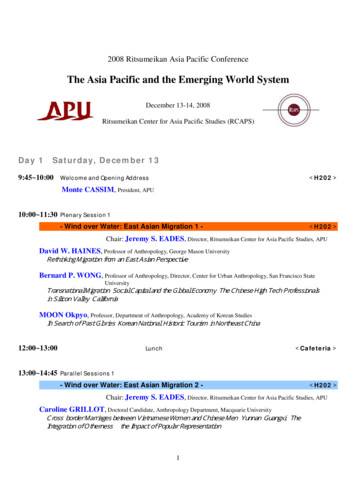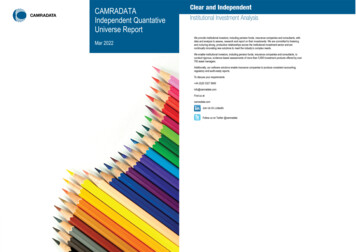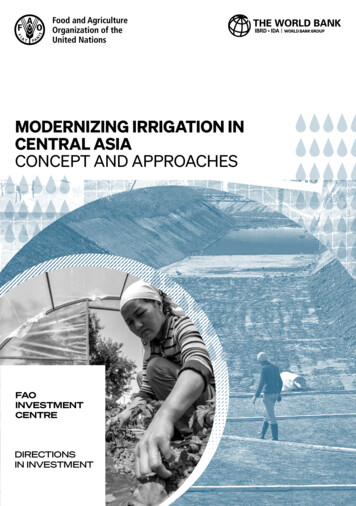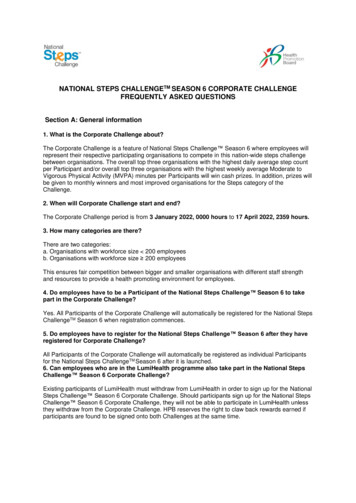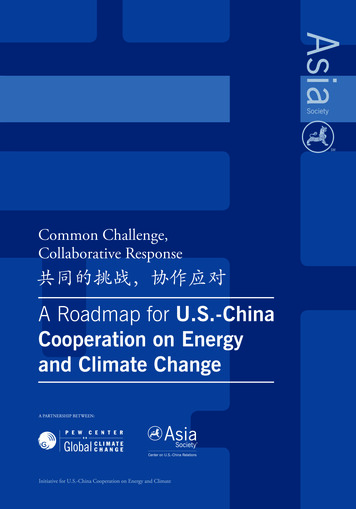
Transcription
Common Challenge,Collaborative ResponseA Roadmap for U.S.-ChinaCooperation on Energyand Climate ChangeJanuary 2009A partnership BETWEEN:Center on U.S.-China Relations
Asia SocietyRichard Holbrooke, ChairmanVishakha Desai, PresidentInitiative for U.S.-China Cooperation on Energy and ClimateA Partnership Between:Asia Society Center on U.S.-China RelationsOrville SchellArthur Ross DirectorBanning GarrettDirector, Initiative for U.S.-China Cooperation on Energy and ClimateJoanna LewisInitiative Research DirectorAssistant Professor, Georgetown University School of Foreign ServiceJonathan AdamsInitiative Assistant DirectorandPew Center on Global Climate ChangeEileen ClaussenPresidentElliot DiringerVice President, International StrategiesProject Co-ChairsSteven ChuDirector, Lawrence Berkeley National Laboratory; Professor of Physics and Molecular andCellular Biology, University of California, Berkeley*John ThorntonChairman, The Brookings Institution; Professor, Tsinghua University; Board Member, AsiaSocietySenior AdvisorsJon Anda Board Member, Asia Society; former Vice Chairman, Morgan StanleyMaria Cantwell, U.S. Senator (D – Washington)Dianne Feinstein U.S. Senator (D – California)Henry Kissinger Former Secretary of StateGavin Newsom Mayor of San FranciscoLee Scott CEO, Wal-MartLaura D’Andrea Tyson S.K. and Angela Chan Professor, Haas School of Business, University ofCalifornia, Berkeley; former Chairman of the President’s Council of Economic Advisors*Co-chair until nominated by President-Elect Obama to be Secretary of Energy.2
This project arose and evolved through collaboration that alsoincluded the following groups and individuals:The Brookings Institution: Kenneth Lieberthal and David SandalowCouncil on Foreign Relations: Elizabeth Economy and Michael LeviEnvironmental Defense Fund: Peter Goldmark and David YarnoldNational Committee on U.S.-China Relations: Steve Orlins and Jan BerrisContributorsJeffrey A. Bader Director, John L. Thornton China Center, The Brookings InstitutionJan Berris Vice President, National Committee on U.S.-China RelationsLarry Brilliant Executive Director, Google.orgWilliam Chandler Director, Energy and Climate Program, Carnegie EndowmentCheng Siwei Former Vice Chairman of the Tenth National People’s Congress Standing CommitteeChu Shulong Deputy Director, Institute of International Strategic and Development Studies,School of Public Policy and Management, Tsinghua UniversityElizabeth Economy C.V. Starr Senior Fellow and Director for Asia Studies, Council on Foreign RelationsGeorge Frampton Pegasus Capital Partners; former Chairman of the White House Council onEnvironmental QualityThomas L. Fraser Attorney, New YorkKelly Sims Gallagher Director, Energy Technology Innovation Policy, Belfer Center for Science andInternational Affairs, Harvard UniversityRobert Gee President, The Gee Strategies GroupPeter Goldmark Program Director, Climate and Air Program, Environmental Defense FundSherri Goodman General Counsel, CNA CorporationDian M. Grueneich Commissioner, California Public Utilities CommissionHarry Harding Senior Fellow, Center on U.S.-China Relations; University Professor ofInternational Affairs, George Washington UniversityTony Haymet Director of Scripps Institution of Oceanography, University of California, San DiegoTom Heller Professor of International Legal Studies, Stanford University Law SchoolIsabel Hilton Editor, China DialogueJohn Holdren Director, Woods Hole Research Center; Director, Program on Science, Technology andPublic Policy, Kennedy School of Government, Harvard UniversityTrevor Houser Partner, the Rhodium Group; Visiting Fellow, Peterson Institute for InternationalEconomicsS.T. Hsieh Director, U.S.-China Energy and Environment Technology Center, Tulane UniversityHuang Ping Director General, Institute of American Studies, Chinese Academy of Social SciencesJiang Kejun Director and Research Professor, Energy System Analysis and Market Analysis ResearchCenter, Energy Research Institute, China National Development and Reform CommissionC.S. Kiang Chairman, Peking University Environment FundLin Jiang Vice President and Director of the China Sustainable Energy Program, Energy FoundationDaniel M. Kammen Professor, Energy and Resources Group, Goldman School of Public Policy,and Department of Nuclear Engineering, and Founding Director, Renewable and Appropriate EnergyLaboratory, University of California, BerkeleyDavid M. Lampton Director, China Studies, The Paul H. Nitze School of Advanced International Studies,Johns Hopkins UniversityMichael Levi Senior Fellow for Energy and the Environment and Director of the Program on Energy Securityand Climate Change, Council on Foreign Relations3
Mark Levine Professor, University of California, Berkeley; Director, Environmental Energy TechnologiesDivision Lawrence Berkeley National LaboratoryKenneth Lieberthal Professor of Political Science and Business Administration, University of Michigan;Visiting Fellow in Foreign Policy, The Brookings InstitutionMaura O’Neill Chief of Staff for Senator Maria CantwellStephen Orlins President, National Committee on U.S.-China RelationsWilliam Nitze Chairman, OceanaPan Jiahua, Executive Director, Research Center for Sustainable Development, Chinese Academy ofSocial SciencesDavid Pumphrey Deputy Director, Energy and National Security Program, Center for Strategic andInternational StudiesQi Ye Professor, Director of the Institute of Public Policy, School of Public Policy and Management,Tsinghua UniversityDavid Sandalow Senior Fellow, Foreign Policy, The Brookings InstitutionShankar Sastry Dean of the College of Engineering, UC BerkeleyPeter Schwartz Chairman, Global Business NetworkDeborah Seligsohn Director, China Program, Climate Energy and Pollution Program, World ResourcesInstituteSusan Shirk Arthur Ross Resident Fellow, Asia Society; Professor of Political Science, University ofCalifornia, San Diego; Director, Institute on Global Conflict and Cooperation; former DeputyAssistant Secretary of StateRob Socolow Professor and Co-Director, The Carbon Mitigation Initiative, Princeton UniversityTodd Stern Senior Fellow, Center for American Progress; Partner, Wilmer-HaleJennifer Turner Director, China Environment Forum, Woodrow Wilson CenterWang Jisi Dean, School of International Studies, Peking UniversityWu Jianmin, President Emeritus, Foreign Affairs UniversityWu Xiaolei Taipu Chair, Professor, Department of Energy and Resources Engineering, Peking UniversityDavid Yarnold Executive Vice President, Environmental Defense FundZha Daojiong Professor, School of International Studies, Peking UniversityZhang Haibin Associate Professor, School of International Studies, Peking University; Member,Expert Team on Trade and Environment, Ministry of CommerceZhang Xiliang Professor of Energy Economics, Executive Director, Institute of Energy and EnvironmentalEconomics, Tsinghua UniversityZhou Dadi Advisor to the National Energy Leading Group, Energy Research Institute, ChinaNational Development and Reform Commission; Senior Associate, Carnegie InstituteEnergy & Climate ProgramZou Ji Vice Dean, School of Environment and Natural Resources, People’s University of China4
ForewordThe world faces no greater challenge in the 21st century than arresting the rapidly increasingaccumulation of greenhouse gases in the atmosphere that cause climate change. The two largestproducers of these gases are the United States and China. Their cooperation is essential if thereis to be a solution to the daunting climate change challenge. If the United States and China canbecome active catalysts in bringing about a strategic transformation to a low-carbon, sustainableglobal economy, the world will take a giant step forward in combating climate change. TheUnited States and China will also edge closer to energy security, protecting their environmentsand assuring greater prosperity for their citizens. Equally important, they will also succeed inbuilding a far more stable and cooperative foundation for U.S.-China relations as a whole.In mid-2007, the Asia Society assembled a group of leading experts from the worlds ofscience, business, academia, politics, and civil society with representatives from the Council onForeign Relations, the Environmental Defense Fund, The Brookings Institution, the NationalCommittee on U.S.-China Relations, and Pew Center on Global Climate Change, to explorehow the United States and China could cooperate more closely on energy and climate change.The result was the establishment of the Initiative for U.S.-China Cooperation on Energyand Climate, generously supported by Asia Society Board Member Jon Anda. The Initiativeevolved into a partnership between the Asia Society’s Center on U.S.-China Relations, underthe leadership of Arthur Ross Director Orville Schell, and Pew Center on Global ClimateChange, under the leadership of Eileen Clausen. The Initiative has also been fortunate to gainthe sponsorship and assistance of the Chinese People’s Institute for Foreign Affairs in Beijing.The goals are two-fold:1. To draft a “Roadmap” for leaders of the two countries to scale up sharply U.S.-Chinacooperative projects on energy and climate change.2. To catalyze a major new collaboration in this key area of common interest to put Sino-U.S.bilateral relations on a more stable basis.This Report explicates both a rationale and an outline for beginning a more comprehensiveprogram of U.S.-China collaboration on energy and climate change that builds on decadesof U.S.-China cooperation on energy and environment. It calls for initial engagement at apresidential summit, but also outlines some of the critical project areas that should be jointlyexplored through practical collaboration by officials at other levels of government as well asby the private sector. Each of our recommended areas of common endeavor—which includecoal, energy efficiency, “smart” grids, and renewable energy—should be elaborated throughthe early appointment of Task Forces assigned to develop a detailed plan of collaboration andimplementation in each area.Drafts of this Report were reviewed in both the United States and China by a broad arrayof specialists, all of whom share the goal of developing a collaborative plan that would be viewedby Chinese leaders and the new U.S. presidential administration as workable and helpful inaccomplishing the above goals.Richard C. HolbrookeChairman, Asia Society5
Executive SummaryA new comprehensive program for cooperation between the United States and Chinathat focuses on reducing greenhouse gas emissions, and thus mitigating the potentiallycatastrophic effects of climate change, is both necessary and possible. Indeed, as this Reportsuggests, if human beings hope to avoid the worst consequences of global climate change, theUnited States and China—respectively the world’s largest developed and developing nations,the two largest energy consumers, and the two largest producers of greenhouse gases—haveno alternative but to become far more active partners in developing low-carbon economies.To prevail in such a common effort, both countries will need not only bold leadershipand a new set of national policies, but also a path-breaking cooperative agenda that canbe sustained over the long run. The advent of a new U.S. presidential administration inWashington, D.C., coupled with a central leadership in Beijing that is increasingly aware ofthe destructive impact and long-term dangers of climate change, presents an unparalleledopportunity for this new strategic partnership.While the current global economic crisis could make joint action between the UnitedStates and China more difficult, it could also provide an unexpected impetus. If wiselyallocated, funds invested by both governments in economic recovery can help address climatechange while also advancing the “green technologies” and industries that will lead to a newwave of economic growth.Stronger bilateral collaboration on energy and climate change has at the same time thereal prospect of helping to build a new, more stable, and constructive foundation under SinoAmerican relations, the most important bilateral relationship in the 21st century world.This Report—which was produced in partnership between Asia Society’s Center onU.S.-China Relations and Pew Center on Global Climate Change, in collaboration withThe Brookings Institution, Council on Foreign Relations, National Committee on U.S.China Relations, and Environmental Defense Fund—presents both a vision and a concreteRoadmap for such Sino-U.S. collaboration. With input from scores of experts and otherstakeholders from the worlds of science, business, civil society, policy, and politics in bothChina and the United States, the Report, or “Roadmap,” explores the climate and energychallenges facing both nations and recommends a concrete program for sustained, high-level,bilateral engagement and on-the-ground action. The Report and its recommendations arebased on the following understandings: That because there is overwhelming scientific consensus that human-induced climatechange is well underway and poses grave economic and environmental risks to the world,the United States and China need to immediately begin acting in concert, withoutawaiting new domestic legislation or multilateral agreements, to jointly seek remedies fortheir emissions of greenhouse gases. That because climate change is largely a consequence of soaring global use of fossil fuels,addressing the problem will require a fundamental transformation of energy systems inboth countries, as well as worldwide, through the development and deployment of newtechnologies and the widespread introduction of new energy sources capable of enhancingthe diversity, reliability, independence, and “greenness” of national energy supplies.6
That even during a time of global economic upheaval, a strong bilateral effort to addressthe twin challenges of climate change and energy security can succeed while alsocontributing to economic recovery and laying the foundation for a prosperous, new, lowcarbon economy in each country. That a meaningful U.S.-China partnership on climate change issues can be forged on thebasis of equity, taking into account the respective stages of development, capacities, andresponsibilities of each country. That while enhanced U.S.-China cooperation must begin with collaboration betweenthe two national governments, success will ultimately hinge on each nation’s ability tocatalyze action and investment in the marketplace. That if fashioned carefully, closer collaboration on energy and climate can address theproblem of climate change and enhance the economic prospects of both nations whileconferring on neither an unfair competitive advantage. That by demonstrating global leadership and making significant new progress towardcloser bilateral cooperation, the world’s two largest economies will help achievestronger multilateral agreement and action under the United Nations (UN) FrameworkConvention on Climate Change.The Report recommends that, as a first step in forging this new partnership, the leaders ofthe two countries should convene a leaders summit as soon as practically possible following theinauguration of Barack Obama to launch a “U.S.-China Partnership on Energy and ClimateChange.” This presidential summit should outline a major plan of joint-action and empowerrelevant officials in each country to take the necessary actions to ensure its implementation.The Report recommends that the partnership be directed by two parallel groups. A U.S.China high-level council would be established to draw up overall plans for the collaboration.The Commission would include high-ranking environment, energy, and finance officialsfrom both countries. It would meet regularly to establish and review the strategic directionof the new partnership as well as to discuss other issues of common concern, including thoserelating to ongoing multilateral negotiations.In addition, each of the highlighted concrete priority areas proposed below would beguided by a second tier of bilateral task forces. These would be composed of senior governmentofficials and independent experts in science, technology, business, finance, civil society, andpolicy from each country. Their responsibilities would involve establishing goals, designatingjoint-research areas, developing collaborative programs within each of the designatedareas, organizing concrete joint projects in each area of cooperation, and overseeing theimplementation of these projects.Areas where direct collaboration is expected to yield the quickest and most substantialresults on reducing greenhouse gas emissions have been given highest priority. They are listedbelow in shortened form, but discussed in greater detail in Section IV.Priority areas of collaboration include: Deploying Low-Emissions Coal Technologies. The likelihood that both the United States and China will continue to rely heavilyon coal for many years to come necessitates immediate and large-scale investments in7
the research, development, and deployment of new technologies for the capture andsequestration of carbon emissions from coal-fired power plants. Improving Energy Efficiency and Conservation. Both the United States and China have significant potential to lower their carbonemissions through low-cost, and even no-cost, energy efficiency and conservationmeasures that would have considerable impact on each country’s “carbon footprint” andenergy security. Developing an Advanced Electric Grid. Both the United States and China rely on outdated, decentralized, and inefficientelectrical transmission systems. Both countries could profit from research, development,and adoption of new “smart grid” technologies capable of enabling these systems tohandle larger quotients of low-carbon energy from episodic, but renewable sources ofpower more cheaply and efficiently. Promoting Renewable Energy. There is an obvious need for both countries to develop a far broader deployment of solar,wind, and other renewable sources of energy in order to de-carbonize their respectiveelectricity systems, expand their low-carbon economies, and thereby diminish theircarbon emissions per unit of GDP. Quantifying Emissions and Financing Low-Carbon Technologies. To help facilitate cooperation in the above areas, it will be important to continue tojointly address the cross-cutting issues of quantifying and projecting emissions, andfinancing technology development and deployment.That our planet is now approaching a point of no return on the question of global warmingis increasingly self-evident. Recognition of the daunting challenges that such moments posecan be unsettling, even paralyzing. However, with bold leadership, they can also be galvanic.It is unclear as yet whether the growing awareness of our tipping point moment willintersect in a timely manner with the new leadership that is now assuming office in Washingtonand the increasingly well-informed central leadership in Beijing to catalyze both countriestoward mustering the necessary clarity of vision, intellectual resources, funding, technology,and international cooperation. What is clear, however, is that we are in uncharted watersthat will beg an unprecedented effort from both the world at large and the United States andChina in particular. For whether we choose to recognize it or not, these two countries areboth crucial in the effort to address climate change. Simply put, if these two countries cannotfind ways to bridge the long-standing divide on this issue, there will literally be no solution.Fortunately, it is the firm conviction of those who have worked on this Report over thepast year that the United States and China will both benefit from the kind of collaborationoutlined herein. Moreover, not only would such a collaboration allow the world to take a giantstep forward in confronting the global climate change challenge, but both the United Statesand China would indirectly stand to profit immeasurably from it. If their leaders jointly playtheir cards astutely, the two countries could find themselves in the forefront of a new greentech economy, and in a stronger, more strategic partnership, better able to help lead the worldto meet other 21st century challenges.8
ContentsForeword . . . . . . . . . . . . . . . . . . . . . . . . . . . . . . . . . . . . . . . . . . . . . . . . . . . . . . . . . . . . . 5Executive Summary . . . . . . . . . . . . . . . . . . . . . . . . . . . . . . . . . . . . . . . . . . . . . . . . . . . . . 6I. Introduction . . . . . . . . . . . . . . . . . . . . . . . . . . . . . . . . . . . . . . . . . . . . . . . . . . . . . . . . 10Roadmap Recommendations . . . . . . . . . . . . . . . . . . . . . . . . . . . . . . . . . . . . . . . . . 12II. Catalyzing a Second Strategic Transformation . . . . . . . . . . . . . . . . . . . . . . . . . . . . . 14III. Our Common Challenge . . . . . . . . . . . . . . . . . . . . . . . . . . . . . . . . . . . . . . . . . . . . . 16The Climate Trajectory . . . . . . . . . . . . . . . . . . . . . . . . . . . . . . . . . . . . . . . . . . . . . . 16Energy, Emissions, and National Circumstances . . . . . . . . . . . . . . . . . . . . . . . . . . 18Efforts to Date . . . . . . . . . . . . . . . . . . . . . . . . . . . . . . . . . . . . . . . . . . . . . . . . . . . . 26IV. A Collaborative Response . . . . . . . . . . . . . . . . . . . . . . . . . . . . . . . . . . . . . . . . . . . . . 281. Deploying Low-Emissions Coal Technologies . . . . . . . . . . . . . . . . . . . . . . . . . . . 282. Improving Energy Efficiency and Conservation . . . . . . . . . . . . . . . . . . . . . . . . . 323. Developing an Advanced Electric Grid . . . . . . . . . . . . . . . . . . . . . . . . . . . . . . . . 354. Promoting Renewable Energy . . . . . . . . . . . . . . . . . . . . . . . . . . . . . . . . . . . . . . . 375. Quantifying Emissions and Financing Low-Carbon Technologies . . . . . . . . . . 40V. Getting Started . . . . . . . . . . . . . . . . . . . . . . . . . . . . . . . . . . . . . . . . . . . . . . . . . . . . . 45VI. Conclusion . . . . . . . . . . . . . . . . . . . . . . . . . . . . . . . . . . . . . . . . . . . . . . . . . . . . . . . 47Acknowledgments . . . . . . . . . . . . . . . . . . . . . . . . . . . . . . . . . . . . . . . . . . . . . . . . . . . . . 49Appendix I. Timeline of Government Initiatives for U.S.-China Energy and ClimateChange Cooperation . . . . . . . . . . . . . . . . . . . . . . . . . . . . . . . . . . . . . . . . . . . . . . . . 50Appendix II: List of Acronyms . . . . . . . . . . . . . . . . . . . . . . . . . . . . . . . . . . . . . . . . . . . . 559
I. IntroductionOf the many issues crowding the international agenda, there is perhaps none so pressing,nor so quintessentially global, as the rising threat of climate change. In its causes andpotential consequences, climate change has implications for every inhabitant of everynation on earth. Yet the power to mobilize an effective response rests largely with a handfulof nations. There are two in particular without which it will not be possible to find ameaningful remedy. The United States and China—the world’s largest developed anddeveloping nations, the two largest energy consumers, and the two largest producers ofgreenhouse gases—must be partners in any effort to avert catastrophic climate change andusher in a new and prosperous low-carbon global economy.The advent of a new U.S. administration presents an unparalleled opportunity fora new strategic partnership between the United States and China that promises a moresustainable future for both nations and for the world.1 The United States and China shoulddevelop a sustained cooperative agenda as well as national policies to catalyze a new globalstrategic transformation to sustainable, low-carbon economic development. Through directcollaboration, the two countries can together advance key technologies and practices thatwill help to reduce their greenhouse gas emissions, while also addressing their critical energysecurity needs. The current global economic crisis, far from being a deterrent, should provideeven stronger impetus for efforts to develop a low-carbon economy generating green jobsand sustainable growth. At the same time, stronger bilateral collaboration on energy andclimate can provide the leadership and momentum needed to achieve a true global climateaccord, and build a stronger foundation for future Sino-American cooperation on otherstrategic challenges facing both nations in the 21st century.This Report presents both a vision and a concrete Roadmap for this new collaboration.With input from scores of experts, stakeholders, and policymakers from the worlds ofscience, business, civil society, policy, and politics in China and the United States, theReport explores the climate and energy challenges facing both nations and recommends aprogram for sustained high-level engagement and on-the-ground action. The Report andits recommendations are based on the following understandings:Action is Urgent. The United States and China should start now. There is overwhelmingscientific consensus that human-induced climate change poses grave economic and environmental risks. Minimizing these risks requires that global greenhouse gas emissions, now rising at an unprecedented rate, peak as soon as possible and decline dramatically over the coming decades. Accomplishing this goal will be feasible only through concerted and sustainedaction, beginning immediately. The United States and China should not await new domesticlegislation or multilateral agreements before launching stronger collaborative efforts.1For a thorough assessment of the politics and prospects of enhancing cooperation between the United States and Chinaon climate change, see Kenneth Lieberthal and David Sandalow, Overcoming Obstacles to U.S.-China Cooperation onClimate Change, The Brookings Institution, Washington, D.C., January 2009.10
A Path to Energy Security. Climate change is largely a consequence of soaring globalenergy use, and addressing it requires a fundamental transformation of energy systemsworldwide. This transformation presents an unparalleled opportunity to simultaneouslyaddress the urgent energy security challenges confronting the United States, China, andother nations by introducing new sources and technologies capable of enhancing thediversity, reliability, and independence of national energy supplies.New Economic Opportunity. At a time of global economic upheaval, strong effortsto address the twin challenges of climate change and energy security can contribute toeconomic recovery, while laying the foundation for a prosperous new low-carbon economy.The near-term investments that are needed will produce substantial long-term dividendsthrough sustainable growth and employment. Conversely, delaying these investments willrisk severe economic harm and drive up the cost of minimizing the impact of climatechange.Common but Differentiated Responsibilities. As a point of departure, an equitablepartnership must be built on a shared understanding of respective responsibilities andcapacities. As the world’s largest economy and largest historic greenhouse gas emitter,the United States must demonstrate leadership by moving swiftly to reduce its emissionsthrough mandatory national legislation. Although China has now surpassed the UnitedStates as the world’s largest annual emitter, its cumulative and per capita emissions are muchlower, and development and poverty reduction will remain overriding national priorities forthe foreseeable future. Having adopted a comprehensive national climate change program,National Climate Change Program, and agreed on the need to reduce its emissions below“business as usual,” China must now deliver an ambitious and effective national effort.2Public-Private Engagement. While enhanced U.S.-China cooperation must begin withcollaboration between the national governments, success will hinge on each nation’s abilityto catalyze action by the private sector. Technology can be advanced, financing secured,and critical obstacles overcome only through a combination of bold leadership, ingenuity,expertise, and the mustering of the resources of leading investors, financial institutions,and companies in both the United States and China. But governments will play a criticalrole in creating the regulatory environment for large-scale private investment in andcommercialization of low-carbon technologies through a wide range of tools, from taxincentives and subsidies to regulations and research.2The G5 Statement issued by Brazil, China, India, Mexico, and South Africa on the occasion of the 2008 HokkaidoToyako Summit, Sapporo, July 8, 2008, says on this point: “We, on our part, are committed to undertaking nationallyappropriate mitigation and adaptation actions which also support sustainable development. We would increase the depthand range of these actions supported and enabled by financing, technology and capacity-building with a view to achieving a deviation from business-as-usual. -g5.html11
Cooperating while Competing. Fear of competitive harm has for too long stood as anobstacle to strong climate action. Competition can also be an engine for innovation andlow-carbon growth. Under any scenario, companies and industries in the United States andChina will remain vigorous economic competitors in the global marketplace. Fashionedcarefully, closer collaboration on energy and climate can enhance the economic prospectsof both nations while conferring on neither an unfair competitive advantage.Bilateral Means to Multilateral Ends. Climate change requires a global response, andstronger bilateral cooperation between the United States and China must contribute to,not deter, an effective multilateral climate
Laboratory, University of California, Berkeley David M. Lampton Director, China Studies, The Paul H. Nitze School of Advanced International Studies, Johns Hopkins University Michael Levi Senior Fellow for Energy and the Environment and Director of the Program on Energy Security and Climate Change, Council on Foreign Relations


